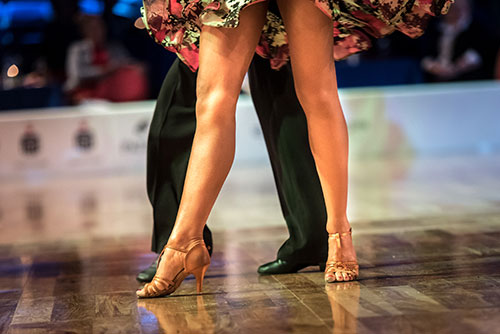Sports Injury Treatment
 In addition to playing a vital role in our daily activities like walking and just getting about, our feet support more active movements like running, jumping and even dancing – all while supporting our full body weight and the requisite forces being applied to those actions. Because our feet are comprised of a quarter of the total number of bones in our whole bodies, as well as the tendons, ligaments, and muscles holding them all together, this makes them particularly vulnerable to injury. In fact, the most common foot trauma and fracture is from sport-related injury. Compound that vulnerability from weakened bones caused by medical conditions like arthritis, and you become even more susceptible to injury or fracture.
In addition to playing a vital role in our daily activities like walking and just getting about, our feet support more active movements like running, jumping and even dancing – all while supporting our full body weight and the requisite forces being applied to those actions. Because our feet are comprised of a quarter of the total number of bones in our whole bodies, as well as the tendons, ligaments, and muscles holding them all together, this makes them particularly vulnerable to injury. In fact, the most common foot trauma and fracture is from sport-related injury. Compound that vulnerability from weakened bones caused by medical conditions like arthritis, and you become even more susceptible to injury or fracture.
Sports medicine podiatry focuses on preventing, diagnosing, and treating injuries of the foot relating to sports and/or exercise. A podiatrist specializing in sports medicine has immense knowledge of sports science. For Dr. Namen, this means he has expert knowledge of how muscles, bones, and soft tissues interact during different types of sports. Not only is he able to identify and diagnose general health conditions that may affect the foot and ankle, Dr. Namen is proficient in providing comprehensive treatment options–from preventive measures to therapy and even surgery if necessary. The team at Namen Podiatry also offers advanced treatment protocols for patients with sports-related injuries that are customized to each patient’s unique needs and competences. Most importantly, they help patients return to their sport as quickly as possible.
If you have suffered a sports-related injury to your foot or ankle it is important to seek medical care right away. If, however, after initial care you have a concern about the progression of your treatment or your condition is not improving, Namen Podiatry could help you find the right solution to getting back in the game. After all, nothing should affect your love of playing sports, hitting the dance floor or having an active lifestyle.
Our podiatry specialists offer treatment for a variety of injuries and conditions.
Toggle below to learn more about the most common sports-related injuries we treat.
Although simply walking on slippery or uneven surfaces can lead to an inadvertent sprain, so too can any sport that involves jumping or running put you at risk. A sprain occurs when the ankle rolls or twists awkwardly, stretching or potentially tearing the connective tissue (ligaments) connecting the bone and joints. With the resulting sprain there may be pain, swelling and the ankle can feel tender.
Ankle sprains can be broken into three categories. A first-degree sprain is the least severe and a third-degree sprain usually indicates that the ligament is completely torn, significantly compromising the ankle’s stability. In some cases, a fracture can also accompany an ankle sprain. Healing from an ankle sprains can take up to 2 months in some cases, however if a ligament is fully torn, surgery may be required and healing will require longer treatment and therapy.
For self-care of an ankle sprain, use the RICE method (rest, ice, compression, elevation). If this does not alleviate symptoms, Dr. Namen may recommend further treatment such as immobilization, taping, a splint, or possibly a cast to help secure the ankle in the proper position to aid healing. It should be noted, ankle sprain sufferers are susceptible to repeated injury due to instability in the ankle thereby compromising athletic performance until the ankle is fully healed.
Trauma to the foot or ankle usually manifests with immediate pain and swelling, creating difficulty walking or standing on the affected foot. Sometimes this trauma can include a bone fracture which may be more problematic than you might think. Fractures in the foot can lead to blood vessel complication and if the bone breaks the skin there is added risk from infection. If you have hurt your angle and suspect you may have a fracture, you should seek urgent medical assistance regardless of how mild you believe your symptoms.
Ultimately, treatment for foot trauma depends on the nature and extent of the injury. For example, stress fractures (tiny cracks in the bone usually due to repetitive stress) may be able to heal on their own with rest. With some breaks, immobilization with a splint, cast, or walking boot may be required to immobilize the area to aid recovery. While a significant break may necessitate surgery to ensure proper healing.
Acting like a shock absorber when you walk, your plantar fascia is the thick band of connective tissue that runs from your toes to your heel. It supports the arch of your foot and if under repeated strain, can become inflamed and develop little tears, causing sever heel pain. This is plantar fasciitis. Sharp and localized, plantar fasciitis pain is more pronounced with the first steps in the morning.
There are several factors which can lead to plantar fasciitis, although tight calf muscles are typically to blame as they make the ankle less flexible, which in turn tightens the plantar fascia when walking or running. Although inadequate arch support, an uneven gait, obesity, and even standing for long periods on hard surfaces may lead to the issue, plantar fasciitis can be a recurring condition and worsen over time.
Often as a result of plantar fasciitis, patients can also develop heel spurs, or calcium growths on the underside of the heel bone. While some patients with heel spurs don’t experience pain, when they do it is usually because of an accompanying soft-tissue injury in the immediate area of the spur. Healing from plantar fasciitis can take months and Dr. Namen may prescribe a combination of anti-inflammatory medication, cold therapy, stretching exercises, proper footwear with orthotics support, or even night splints to stretch your calf and foot arch while you sleep. In worsening or more complex cases, Dr. Namen may recommend shockwave therapy or even surgery.
A common cause of heel pain, particularly among runners, is Achilles tendonitis wherein the tendon becomes inflamed from repetitive strain over time. The largest tendon in the body, the Achilles tendon connects the calf muscle to the heel bone. While the pain from Achilles tendonitis occurs within the tendon itself, most sufferers feel pain in the back of the heel where the tendon attaches to the heel bone. Additionally, bone spurs can also develop alongside this condition when damaged tendon fibers harden or calcify where they attach to the bone.
Most often, Achilles tendonitis can be treated successfully and non-surgically with rest, cold therapy, orthotics and/or physical therapy. In some instances, Dr. Namen may prescribe non-steroidal anti-inflammatory, cortisone injections or even shockwave therapy for more complex or stubborn cases.
Sports Injury Prevention
At Namen Podiatry, our specialized team doesn’t just treat sports injuries, we work with you to prevent future injuries by helping improve your athletic performance and fitness levels. In establishing stability and conditioning exercises appropriate to your athletic level and need, we can help you avoid foot and ankle injuries common to your sport or physical activity.
Whether a serious athlete or a casual sports enthusiast, if you’ve suffered a foot or ankle injury, Dr. Namen and the team can offer suggestions to help you achieve your best success both safely and confidently. With a whole host of treatment options available, Namen Podiatry will help keep you, on the road, in the game or just doing all the activities you love.
